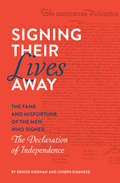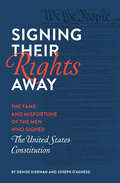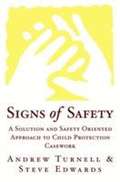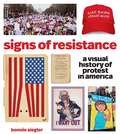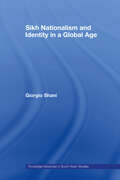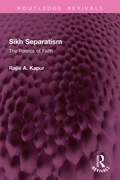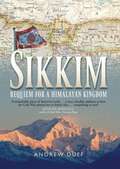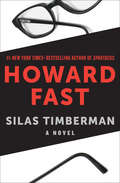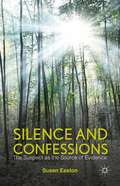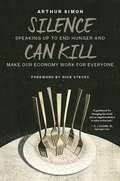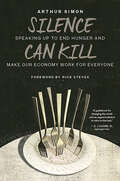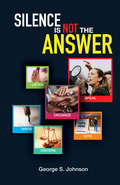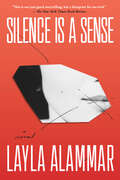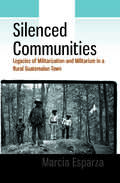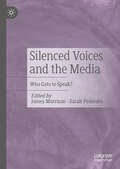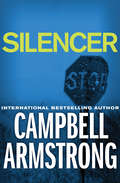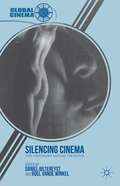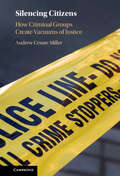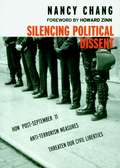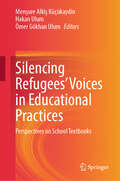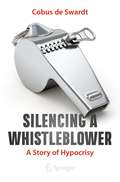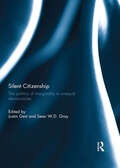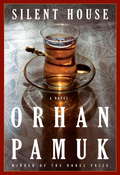- Table View
- List View
Signing Their Lives Away: The Fame and Misfortune of the Men Who Signed the Declaration of Independence
by Denise Kiernan Joseph D'AgneseIn July 1776, fifty-six men risked their lives and livelihood to defy the British and sign the most important document in the history of the United States and yet how many of them do we actually remember?Signing Their Lives Awayintroduces readers to the eclectic group of statesmen, soldiers, criminals, and crackpots who were chosen to sign this historic document and the many strange fates that awaited them. Some died from war-related injuries; others had their homes and farms seized by British soldiers; a few rose to the highest levels of U. S. government (ten signers were later elected to Congress). George Wythe was murdered by his nephew; Button Gwinnet was killed in a duel; and of course Sam Adams went on to fame and fortune as a patriot/brewer. Complete with a reversible parchment jacket (offering a facsimile of the Declaration on the reverse),Signing Their Lives Awayprovides an entertaining and enlightening narrative for history buffs of all ages.
Signing Their Rights Away: The Fame and Misfortune of the Men Who Signed the United States Constitution
by Denise Kiernan Joseph D'AgneseUnfold Book Jacket for a Full-Color Reproduction of the U.S. ConstitutionWith their book Signing Their Lives Away, Denise Kiernan and Joseph D'Agnese introduced readers to the 56 statesmen (and occasional scoundrels!) who signed the Declaration of Independence. Now they've turned their attention to the 39 men who met in the summer of 1787 and put their names to the U.S. Constitution. Signing Their Rights Away chronicles a moment in American history when our elected officials knew how to compromise--and put aside personal gain for the greater good of the nation. These men were just as quirky and flawed as the elected officials we have today: Hugh Williamson believed in aliens, Robert Morris went to prison, Jonathan Dayton stole $18,000 from Congress, and Thomas Mifflin was ruined by alcohol. Yet somehow these imperfect men managed to craft the world's most perfect Constitution. With 39 mini-biographies and a reversible dust jacket that unfolds into a poster of the original document, Signing Their Rights Away offers an entertaining and enlightening narrative for history buffs of all ages.From the Hardcover edition.
Signs Of Safety: A Solution And Safety Oriented Approach To Child Protection Casework
by Steve Edwards Andrew TurnellThis book presents a revolutionary approach to child protection work. It focuses on the question, "How can child protection professionals actually build partnerships with parents where there is suspected or substantiated child abuse or neglect?" The authors bring the solution orientation to child protection work, expanding the investigation of risk to encompass signs of safety that can be built upon to stabilize and strengthen the child's and family's situation. The philosophy behind this approach is clearly articulated through ten practice principles that serve as guiding beacons for child protection workers as they traverse the rough waters of abuse and neglect investigation. Child protection workers are involved with vulnerable, at-risk children in potentially volatile situations. Here they will find a new child protection assessment and planning protocol that allows for comprehensive risk assessment incorporating both danger and safety and the perspectives of both professionals and service recipients (parents). The authors provide practical, hands-on strategies for building a partnership with parents, which may, in the long run, prevent abuse and family dissolution. They illustrate these strategies in cases showing the subtle process of integrating the seemingly opposite notions of coercion and cooperation. Respectful, optimistic, and highly practical, this book promises to revitalize and redirect child protection services.
Signs of Resistance: A Visual History of Protest in America
by Bonnie Siegler“Clever images of dissent are not a recent phenomenon in the United States. . . . [Signs of Resistance is] visually fascinating. . . . [and] there is bigly wit here, too.”—The Washington Post In hundreds of iconic, smart, angry, clever, unforgettable images, Signs of Resistance chronicles what truly makes America great: citizens unafraid of speaking truth to power. Two hundred and forty images—from British rule and women’s suffrage to the civil rights movement and the Vietnam War; from women’s equality and Black Lives Matter to the actions of our forty-fifth president and the Women’s March—offer an inspiring, optimistic, and visually galvanizing history lesson about the power people have when they take to the streets and stand up for what’s right.
Sikh Nationalism and Identity in a Global Age (Routledge Advances in South Asian Studies #Vol. 9)
by Giorgio ShaniSikh Nationalism and Identity in a Global Age examines the construction of a Sikh national identity in post-colonial India and the diaspora and explores the reasons for the failure of the movement for an independent Sikh state: Khalistan. Based on a decade of research, it is argued that the failure of the movement to bring about a sovereign, Sikh state should not be interpreted as resulting from the weakness of the ‘communal’ ties which bind members of the Sikh ‘nation’ together, but points to the transformation of national identity under conditions of globalization. Globalization is perceived to have severed the link between nation and state and, through the proliferation and development of Information and Communications Technologies (ICTs), has facilitated the articulation of a transnational ‘diasporic’ Sikh identity. It is argued that this ‘diasporic’ identity potentially challenges the conventional narratives of international relations and makes the imagination of a post-Westphalian community possible. Theoretically innovative and interdisciplinary in approach, it will be primarily of interest to students of South Asian studies, political science and international relations, as well as to many others trying to come to terms with the continued importance of religious and cultural identities in times of rapid political, economic, social and cultural change.
Sikh Separatism: The Politics of Faith (Routledge Revivals)
by Rajiv A. KapurFirst published in 1986, Sikh Separatism is a comprehensive study of the emergence of Sikh unrest in India. The appearance of Sikh fundamentalism and separatism is not a sudden development. They are both shown to have deep social and historical roots linked to the growth of contemporary Sikh identity, community and organization. The genesis of Sikh communal consciousness and organization lies in a social and religious reform movement among Sikhs from the 1870s to the 1920s. This movement is believed to have moulded Sikh perceptions of their political interests and resulted in the establishment of an institutional framework which has served as an arena and a base for Sikh separatism. The development of this reform movement and its motivations, the strategies and tactics employed by the reformers and its profound political implications are examined. This book will be of interest to students of political science, international relations, and South Asian studies.
Sikkim: Requiem for a Himalayan Kingdom
by Andrew DuffA history of larger-than-life characters and the demise of the tiny Himalayan kingdom nestled between India and China. This is the true story of Sikkim, a tiny Buddhist kingdom in the Himalayas that survived the end of the British Empire only to be annexed by India in 1975.It tells the remarkable tale of Thondup Namgyal, the last King of Sikkim, and his American wife, Hope Cooke, thrust unwittingly into the spotlight as they sought support for Sikkim&’s independence after their &“fairytale&” wedding in 1963. As tensions between India and China spilled over into war in the Himalayas, Sikkim became a pawn in the Cold War in Asia during the 1960s and 1970s. Rumors circulated that Hope was a CIA spy. Meanwhile, a shadowy Scottish adventuress, the Kazini of Chakung, married to Sikkim&’s leading political figure, coordinated opposition to the Palace. As the world&’s major powers jostled for regional supremacy during the early 1970s, Sikkim and its ruling family never stood a chance. On the eve of declaring an emergency across India, Indira Gandhi outwitted everyone to bring down the curtain on the 300-year-old Namgyal dynasty. Based on interviews and archive research, as well as a retracing of a journey the author's grandfather made in 1922, this is a thrilling, romantic, and informative glimpse of a real-life Shangri-La.Praise for Sikkim&“A remarkable piece of detective work…. Fascinating human stories…a very valuable addition to how the Cold War played out in South Asia, and to the history of the foreign policies of China, India, and the U.S.&” —Michael Burleigh, author of The Best of Times, the Worst of Times
Silas Timberman: A Novel
by Howard FastAs the Red Scare grips America, a midwestern literature professor becomes an unlikely hero in the struggle for freedomProfessor Silas Timberman has never been one for theatrics. A quiet American literature professor at a mid-sized college, Timberman decides to build a semester&’s course around the democratic ideals of Mark Twain—a subject that under normal circumstances would not arouse the suspicions of the university administration. But as the Korean War rages on and congressional investigations of potential Communists gain traction, no amount of ideological nuance is safe. When Timberman is asked to renounce his work or face the repercussions, he finds that not only his tenure but also his very freedom is at stake. Inspired by Fast&’s own persecution at the hands of the House Un-American Activities Committee, Silas Timberman is a gripping record of the injustices of McCarthyism and a rousing ode to those who fought against it. This ebook features an illustrated biography of Howard Fast including rare photos from the author&’s estate.
Silence And Confessions
by Susan EastonSilence and Confessions examines the treatment of suspects in interrogation and explores issues surrounding the right to silence and confession evidence. Employing a socio-legal approach, it draws from empirical research in the social sciences including social psychology to understand the challenges in obtaining reliable evidence and maintaining the integrity of the interrogation process. Providing insights into the process of interrogation and the experiences of the suspect during interview, this book highlights the dangers facing vulnerable suspects and the problems of identifying and preventing false confessions. It approaches the topic of the right to silence broadly and includes in-depth discussion of the problems with confession evidence. Easton's examination of the relationship between the state and the suspect, the equality of arms principle and the problem of reconciling competing interests and principles in the criminal justice process will be essential reading for scholars in Criminology, Criminal Justice and Law, particularly those interested in the relationship between law and society.
Silence Can Kill: Speaking Up to End Hunger and Make Our Economy Work for Everyone
by Arthur SimonHave faith. End hunger.Ending hunger is a moral imperative that does not stand alone. Hunger thrives on the racial, social, and economic inequalities that are eating away at the soul of our nation and pulling us apart. But ending hunger could now become the cause that brings us together across partisan lines to make our economy include everyone and work for everybody. The goal of ending hunger nationwide is not only noble but easily within reach. Taking up this goal could give us a corrective lens, a lens of hope for seeing ourselves and our country in a new way. It could also give us better vision for helping the world overcome extreme hunger and poverty.Our failure to speak and write to members of Congress about hunger consigns millions of people here and abroad to diminished lives and premature death, so it is a silence that kills. We can break that silence by urging the nation&’s leaders to help end hunger and humanize our economy. This book addresses all people of goodwill, including agnostics and atheists, but with a special word of concern for religious people—Christians in particular—who help through charity, but neglect to use the power of their citizenship against hunger.
Silence Can Kill: Speaking Up to End Hunger and Make Our Economy Work for Everyone
by Arthur SimonHave faith. End hunger.Ending hunger is a moral imperative that does not stand alone. Hunger thrives on the racial, social, and economic inequalities that are eating away at the soul of our nation and pulling us apart. But ending hunger could now become the cause that brings us together across partisan lines to make our economy include everyone and work for everybody. The goal of ending hunger nationwide is not only noble but easily within reach. Taking up this goal could give us a corrective lens, a lens of hope for seeing ourselves and our country in a new way. It could also give us better vision for helping the world overcome extreme hunger and poverty.Our failure to speak and write to members of Congress about hunger consigns millions of people here and abroad to diminished lives and premature death, so it is a silence that kills. We can break that silence by urging the nation&’s leaders to help end hunger and humanize our economy. This book addresses all people of goodwill, including agnostics and atheists, but with a special word of concern for religious people—Christians in particular—who help through charity, but neglect to use the power of their citizenship against hunger.
Silence Is Not the Answer
by George S. JohnsonIN THIS AGE OF CONFUSION, FEAR, AND CONFLICT, PROPHETIC VOICES URGE US TO WAKE UP If you've ever felt like you don't have enough information about an issue, that you should wait to see what others do first, or that your voice won't make a difference, you're not alone. Silence Is Not the Answer is a collection of prophetic voices urging us to wake up, notice what is happening, and take a stand. The book offers viewpoints from a variety of writers who call us to make our voices heard on critical justice issues. Walter Brueggemann, Bishop Herbert Chilstrom, Marcus Borg, Larry Rasmussen, Vivian Elaine Johnson, Jim Wallis, Sallie McFague, and others encourage us to break the silence—not by shouting down others but by starting a real conversation.
Silence Is a Sense
by Layla AlAmmar&“Lyrical, moving, and revealing." —Tracy Chevalier, bestselling author of Girl with a Pearl Earring A transfixing and beautifully rendered novel about a refugee&’s escape from civil war—and the healing power of community. A young woman sits in her apartment, watching the small daily dramas of her neighbors across the way. She is an outsider, a mute voyeur, safe behind her windows, and she sees it all—the sex, the fights, the happy and unhappy families. Journeying from her war-torn Syrian homeland to this unnamed British city has traumatized her into silence, and her only connection to the world is the column she writes for a magazine under the pseudonym &“the Voiceless,&” where she tries to explain the refugee experience without sensationalizing it—or revealing anything about herself. Gradually, though, the boundaries of her world expand. She ventures to the corner store, to a bookstore and a laundromat, and to a gathering at a nearby mosque. And it isn&’t long before she finds herself involved in her neighbors&’ lives. When an anti-Muslim hate crime rattles the neighborhood, she has to make a choice: Will she remain a voiceless observer, or become an active participant in a community that, despite her best efforts, is quickly becoming her own? Layla AlAmmar, a Kuwaiti-American writer and brilliant student of Arab literature, delivers here a complex and fluid book about memory, revolution, loss, and safety. Most of all, Silence is a Sense reminds us just how fundamental human connection is to survival.
Silenced Communities: Legacies of Militarization and Militarism in a Rural Guatemalan Town
by Marcia EsparzaAlthough the Guatemalan Civil War ended more than two decades ago, its bloody legacy continues to resonate even today. In Silenced Communities, author Marcia Esparza offers an ethnographic account of the failed demilitarization of the rural militia in the town of Santo Tomás Chichicastenango following the conflict. Combining insights from postcolonialism, subaltern studies, and theories of internal colonialism, Esparza explores the remarkable resilience of ideologies and practices engendered in the context of the Cold War, demonstrating how the lingering effects of grassroots militarization affect indigenous communities that continue to struggle with inequality and marginalization.
Silenced Voices and the Media: Who Gets to Speak?
by James Morrison Sarah PedersenThis edited collection delves into the multifaceted theme of 'Silenced Voices,' showcasing a diverse array of perspectives from scholars around the globe. From historical reflections to contemporary analyses, the book examines the complex dynamics of voice suppression and enablement across different media landscapes. Divided into four thematic sections, the chapters explore the challenges faced by marginalized and mainstream voices alike. From the portrayal of silenced narratives in the news media to the representation of underrepresented groups in cultural production, the collection spans a wide spectrum of issues. Authors employ varied methodological approaches to investigate the silencing of voices in the realms of politics, society, and professional media practices. Offering fresh insights and critical reflections, this volume serves as a timely contribution to ongoing debates surrounding freedom of expression, fake news, and the complexities of contemporary media environments.
Silencer
by Campbell ArmstrongWhen the US Federal Witness Protection Program fails to protect a star witness, a tough female former prosecutor risks her life to get answers in international bestselling author Campbell Armstrong's high-stakes thriller Reuben Galindez's testimony helped put away brutal arms smuggler Ángel Sanchez, and he thought the trial would be the last time he'd ever have to deal with Sanchez again. Of course Sanchez's organization was looking for him, but Galindez wasn't alone; he had the US government, the FBI, and the Witness Protection Program to keep him safe. When Galindez's body is found floating face-down in the river, riddled with bullets, former state prosecutor Amanda Scholes, who believed she'd put Sanchez in jail forever, is determined to find out what went wrong. Did the witness reveal his identity and leave the program? Did someone from inside Sanchez's organization track down Galindez? Or is his death the result of something far more insidious? Has someone managed to infiltrate the fortresslike security surrounding the program in order to exact revenge?
Silencing Cinema
by Daniel Biltereyst Roel Vande WinkelOppression by censorship affects the film industry far more frequently than any other mass media. Including essays by leading film historians, the book offers groundbreaking historical research on film censorship in major film production countries and explore such innovative themes as film censorship and authorship, religion, and colonialism.
Silencing Citizens: How Criminal Groups Create Vacuums of Justice
by Andrew Cesare MillerCriminal groups, like mafias and gangs, often get away with murder. States are responsible for providing justice but struggle to end this impunity, in part because these groups prevent witnesses from coming forward with information. Silencing Citizens explains how criminal groups constrain cooperation with the police not just by threatening retaliation but also by shaping citizens' perceptions of community support for cooperation. The book details a social psychological process through which criminal group violence makes community support for cooperation appear weaker than it is and thus reduces witnesses' willingness to share information with the police. The book draws on a wealth of data including original surveys in two contrasting cities - Baltimore, Maryland in the Global North and Lagos, Nigeria in the Global South. This title is part of the Flip it Open Programme and may also be available Open Access. Check our website Cambridge Core for details.
Silencing Political Dissent: How Post-September 11 Anti-terrorism Measures Threaten Our Civil Liberties (Open Media Series)
by Nancy ChangIn her groundbreaking new book, Silencing Political Dissent, constitutional expert Nancy Chang examines how the Bush administration's fight against terrorism is resulting in a disturbing erosion of First Amendment rights and increase of executive power.Chang's compelling analysis begins with a historical review of political repression and intolerance of dissent in America. From the Sedition Act of 1798, through the Smith Act of the 1940s and the internment of Japanese Americans in World War II, to the FBI's infamous COINTELPRO program of the 1960s, Chang recalls how during times of crisis and war, the U.S. government has unjustly detained individuals, invaded personal privacy, and hampered the free speech of Americans.Chang's expertise as a senior constitutional attorney shines through in the power and clarity of her argument. Meticulously researched and footnoted, Chang's book forces us to challenge the government when it is unpopular to do so, and to consider that perhaps "our future safety lies in the expansion, rather the contraction, of the democratic values set forth in the Constitution."
Silencing Refugees’ Voices in Educational Practices: Perspectives on School Textbooks
by Ömer Gökhan Ulum Menşure Alkiş Küçükaydin Hakan UlumThis book foregrounds silenced voices by correlating refugee experiences with educational practices, while questioning how we address the educational rights of individuals affected by conflicts and wars. Accordingly, the book presents a novel perspective within the field of education. Within the context of the most prevalent educational instruments, textbooks, this work endeavors to highlight the muted perspectives of immigrants in education and make significant advances towards resolving this problem. Through extensive research and analysis of the relevant literature, the authors shed light on the challenges refugee students face in their educational trajectories and offer innovative suggestions for adopting more equitable and inclusive approaches within our educational systems. The book not only addresses an educational dilemma, but also emphasizes humanity's shared responsibility. Supporting the educational rights of refugees promotes not only their personal growth, but also more tolerant, compassionate, and sustainable societies. At the same time, this work promotes a critical comprehension of refugee experiences in education by presenting both problems and solutions to the readership. In this way, it demonstrates how a more equitable and egalitarian approach to education can be adopted and it ultimately encourages readers to adopt a broader perspective on the world, embracing humanitarian values and social responsibility.
Silencing a Whistleblower: A Story of Hypocrisy
by Cobus de SwardtThis book examines how insufficient policies can lead to the alleged abuse of power in organisations. When independent ethical structures and processes are missing or weak, practices of abuse, misconduct and cover-ups can easily arise at the leadership level. Even organisations that specialise in good governance are no exception, as illustrated by this case study on arguably the world’s most influential anti-corruption NGO, Transparency International (TI). Written by the former Managing Director of Transparency International, this book chronicles its ethical breakdown over a 5-year period starting in 2015. By comparing TI’s whistleblower policies with its internal whistleblower practices, it demonstrates how the organisation gradually became trapped in a vicious cycle of secrecy, corruption and lies. The author chronologically tracks TI’s practices, drawing on 12 whistleblower complaints filed with TI since 2017, as well as communications with TI, international donor agencies, and other international civil society organisations from 2015 to 2020 to do so. The chronological format aptly reveals the snowball effect that ethical weaknesses can create over time, as well as the emotional warfare that whistleblowers are typically subjected to. The unfolding chronology also shows what it means to be a whistleblower for an organisation that avoids public transparency, reporting on and scrutiny of its own practices.
Silencing the Bomb: One Scientist's Quest to Halt Nuclear Testing
by Lynn R. SykesIn December 2016, the Bulletin of Atomic Scientists moved their iconic “Doomsday Clock” thirty seconds forward to two and a half minutes to midnight, the latest it has been set since 1952, the year of the first United States hydrogen bomb test. But a group of scientists—geologists, engineers, and physicists—has been fighting to turn back the clock. Since the dawn of the Cold War, they have advocated a halt to nuclear testing, their work culminating in the Comprehensive Test Ban Treaty, which still awaits ratification from China, Iran, North Korea—and the United States. The backbone of the treaty is every nation’s ability to independently monitor the nuclear activity of the others. The noted seismologist Lynn R. Sykes, one of the central figures in the development of the science and technology used in monitoring, has dedicated his career to halting nuclear testing. In Silencing the Bomb, he tells the inside story behind scientists’ quest for disarmament.Called upon time and again to testify before Congress and to inform the public, Sykes and his colleagues were, for much of the Cold War, among the only people on earth able to say with certainty when and where a bomb was tested and how large it was. Methods of measuring earthquakes, researchers realized, could also detect underground nuclear explosions. When politicians on both sides of the Iron Curtain attempted to sidestep disarmament or test ban treaties, Sykes was able to deploy the nascent science of plate tectonics to reveal the truth. Seismologists’ discoveries helped bring about treaties limiting nuclear testing, but it was their activism that played a key role in the effort for peace. Full of intrigue, international politics, and hard science used for the global good, Silencing the Bomb is a timely and necessary chronicle of one scientist’s efforts to keep the clock from striking midnight.
Silent Cells: The Secret Drugging of Captive America
by Anthony Ryan HatchA critical investigation into the use of psychotropic drugs to pacify and control inmates and other captives in the vast U.S. prison, military, and welfare systemsFor at least four decades, U.S. prisons and jails have aggressively turned to psychotropic drugs—antidepressants, antipsychotics, sedatives, and tranquilizers—to silence inmates, whether or not they have been diagnosed with mental illnesses. In Silent Cells, Anthony Ryan Hatch demonstrates that the pervasive use of psychotropic drugs has not only defined and enabled mass incarceration but has also become central to other forms of captivity, including foster homes, military and immigrant detention centers, and nursing homes. Silent Cells shows how, in shockingly large numbers, federal, state, and local governments and government-authorized private agencies pacify people with drugs, uncovering patterns of institutional violence that threaten basic human and civil rights. Drawing on publicly available records, Hatch unearths the coercive ways that psychotropics serve to manufacture compliance and docility, practices hidden behind layers of state secrecy, medical complicity, and corporate profiteering.Psychotropics, Hatch shows, are integral to &“technocorrectional&” policies devised to minimize public costs and increase the private profitability of mass captivity while guaranteeing public safety and national security. This broad indictment of psychotropics is therefore animated by a radical counterfactual question: would incarceration on the scale practiced in the United States even be possible without psychotropics?
Silent Citizenship: The Politics of Marginality in Unequal Democracies
by Justin Gest and Sean W.D. GrayWhat does silent citizenship mean in a democracy? With levels of economic and political inequality on the rise across the developed democracies, citizens are becoming more disengaged from their neighbourhoods and communities, more distrustful of politicians and political parties, more sceptical of government goods and services, and less interested in voicing their frustrations in public or at the ballot box. The result is a growing number of silent citizens who seem disconnected from democratic politics – who are unaware of political issues, lack knowledge about public affairs, do not debate, deliberate, or take action, and most fundamentally, do not vote. Yet, although silent citizenship can and does indicate deficits of democracy, research suggests that these deficits are not the only reason citizens may have for remaining silent in democratic life. Silence may also reflect an active and engaged response to politics under highly unequal conditions. What is missing is a full accounting of the problems and possibilities for democracy that silent citizenship represents. Bringing together leading scholars in political science and democratic theory, this book provides a valuable exploration of the changing nature and form of silent citizenship in developed democracies today. This title was previously published as a special issue of Citizenship Studies.
Silent House (Vintage International Ser.)
by Orhan Pamuk Robert FinnNever before published in English, Orhan Pamuk's second novel is the story of a Turkish family gathering in the shadow of the impending military coup of 1980. In an old mansion in Cennethisar, a former fishing village near Istanbul, a widow, Fatma, awaits the annual summer visit of her grandchildren. She has lived in the village for decades, ever since her husband, an idealistic young doctor, ran afoul of the sultan's grand vizier and arrived to serve the poor fishermen. Now mostly bedridden, she is attended by her constant servant Recep, a dwarf--and the doctor's illegitimate son. Despite mutual dependency, there is no love lost between mistress and servant, who have very different recollections--and grievances--from the early years, before Cennethisar grew into a high-class resort surrounding the family house, now in shambles. Though eagerly anticipated, Fatma's grandchildren bring little consolation. The eldest, Faruk, a dissipated historian, wallows in alcohol as he laments his inability to tell the story of the past from the kaleidoscopic pieces he finds in the local archive; his sensitive leftist sister, Nilgün, has yet to discover the real-life consequences of highminded politics; and Metin, a high school nerd, tries to keep up with the lifestyle of his spoiled society schoolmates while he fantasizes about going to America--an unaffordable dream unless he can persuade his grandmother to tear down her house. But it is Recep's nephew Hasan, a high school dropout, lately fallen in with right-wing nationalists, who will draw the visiting family into the growing political cataclysm issuing from Turkey's tumultuous century-long struggle for modernity. By turns deeply moving, hilarious, and terrifying, Silent House pulses with the special energy of a great writer's early work even as it offers beguiling evidence of the mature genius for which Orhan Pamuk would later be celebrated the world over.From the Hardcover edition.
